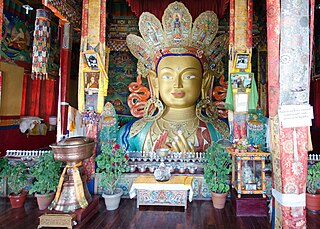
The vast majority of surviving Tibetan art created before the mid-20th century is religious, with the main forms being thangka, paintings on cloth, mostly in a technique described as gouache or distemper, Tibetan Buddhist wall paintings, and small statues in bronze, or large ones in clay, stucco or wood. They were commissioned by religious establishments or by pious individuals for use within the practice of Tibetan Buddhism and were manufactured in large workshops by monks and lay artists, who are mostly unknown. Various types of religious objects, such as the phurba or ritual dagger, are finely made and lavishly decorated. Secular objects, in particular jewellery and textiles, were also made, with Chinese influences strong in the latter.
Miss Tibet is an annual beauty pageant held in McLeod Ganj, India. It is produced by Lobsang Wangyal Productions.
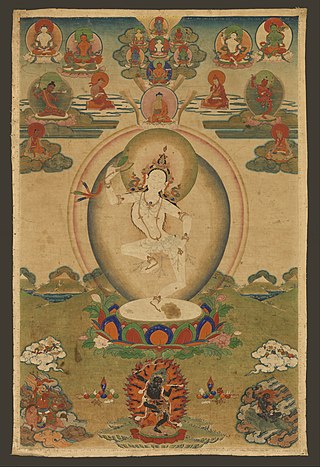
Machig Labdrön, or "Singular Mother Torch from Lab" (1055–1149), was a female Tibetan Buddhist monk believed to be a reincarnation of Yeshe Tsogyal, and the renowned 11th-century Tibetan tantric Buddhist master and yogini that originated several Tibetan lineages of the Vajrayana practice of Chöd.
Yangzom Brauen is a Swiss actress, activist and writer.
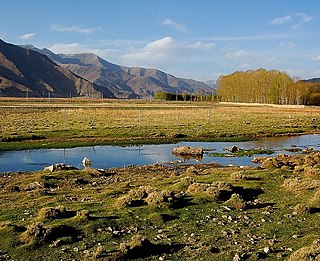
Kongpo is a region of central-eastern Tibet, centered in modern Gongbo'gyamda County, Nyingchi Prefecture. It is situated on the Nyang River, a northern tributary of the Yarlung Tsangpo River.

Tsarong Dasang Dramdul (1888–1959), commonly known mononymously as Tsarong or by his title Tsarong Dzasa, was a Tibetan politician and general in the Tibetan Army. He was a close aide of the 13th Dalai Lama and played an important role in the early twentieth century politics of Tibet. Eager to accelerate economic progression and pursue the modernization of Tibet, Tsarong believed that the old order in Tibet had to be broken by hierarchical reforms to prepare the way for a more modern society which would be compatible with the outside world. In his efforts to build up Tibet's defense systems and relations with European powers as well as to facilitate trade and strengthen the Tibetan currency, he made a series of diplomatic visits to British India. His diplomatic skills came to see him regarded by the British as being, "the most powerful friend of His Majesty's Government in Tibet"
Brauen is a surname. Notable people with the surname include:

Tibetans in Switzerland are people of Tibetan origin or descent living in Switzerland. Tibetans have lived in Switzerland since the 1960s, when the Swiss Red Cross helped resettle 300 Tibetans in Switzerland. In addition, approximately 150 Tibetan orphans were adopted by Swiss families.
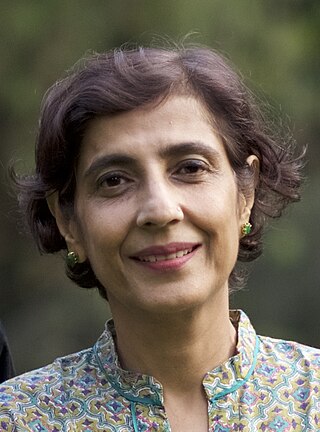
Ritu Sarin is an Indian film director, producer and artist based in Dharamshala, India. She is the director of the Dharamshala International Film Festival.

Tenzing Sonam is a Tibetan film director, writer and essayist based in Dharamshala. He works through his production company, White Crane Films, which he runs with his partner, Ritu Sarin.
Martin Brauen is a cultural anthropologist from Bern, Switzerland who specialises in Tibet, the Himalayas and history of religions.
Tsewang Dolkar Khangkar is a doctor of traditional Tibetan medicine, currently exiled in India.

Who Killed Johnny is a Swiss-American screwball comedy film by Yangzom Brauen, filmed and produced in Los Angeles in 2013.
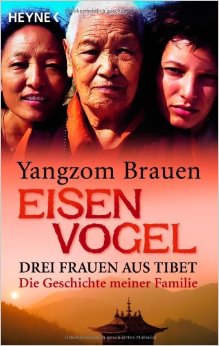
Eisenvogel is a Swiss book published by the Swiss-Tibetan writer, film director, and actress Yangzom Brauen. The full title of the biography is "Eisenvogel: Drei Frauen aus Tibet – Die Geschichte meiner Familie", which literally means Iron bird: Three women from Tibet – The history of my family. First published in 2009, the illustrated book is also distributed as in paperback, eBook, and audiobook forms in German. Brauen later became known for directing Who Killed Johnny.

Escape from Tibet is a 2012 Swiss-German-Tibetan Drama film.

The Tibet women's football team is a national association football team controlled by the Tibet Women's Soccer (TWS), an organization of exiled Tibetans. Its current team manager is Gompo Dorjee.

Lobsang Dolma Khangkar also called Lobsang Dolma or Ama Lobsang Dolma was a 13th generation doctor of traditional Tibetan medicine. She travelled with the Dalai Lama in 1959 from Tibet to India. She was the First woman to become chief physician of the Men-Tsee-Khang. She and the others carried her daughters on their backs into what is now Dharamsala, India: Tsewang Dolkar Khangkar and Pasang Gyalmo Khangkar, succeeded her in the family line of doctors, the Khangkar.

Chamdowa Tsawabomei Shangri Lhagyal (1921–1984) was a Tibetan resistance fighter against Chinese occupying forces in 1958–59. He was one of the commanders of the Chushi Gangdruk guerrillas, and fled to India in April 1959 shortly after the arrival there of the 14th Dalai Lama.
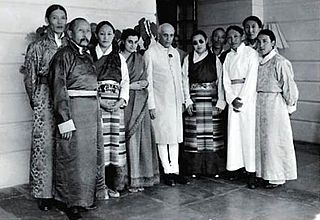
Tsering Dolma was the founder of the non-profit refugee organisation Tibetan Children's Villages and is the older sister of the 14th Dalai Lama, Tenzing Gyatso.
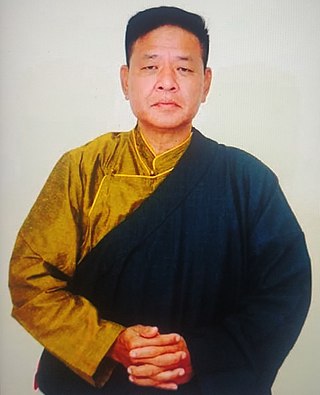
The Central Tibetan Administration, a government-in-exile of Tibet based in India, held an election for its next leader, the Sikyong, in 2021. Candidate Penpa Tsering won the election and succeeded Dr. Lobsang Sangay, who has served for two consecutive terms as Sikyong.

















